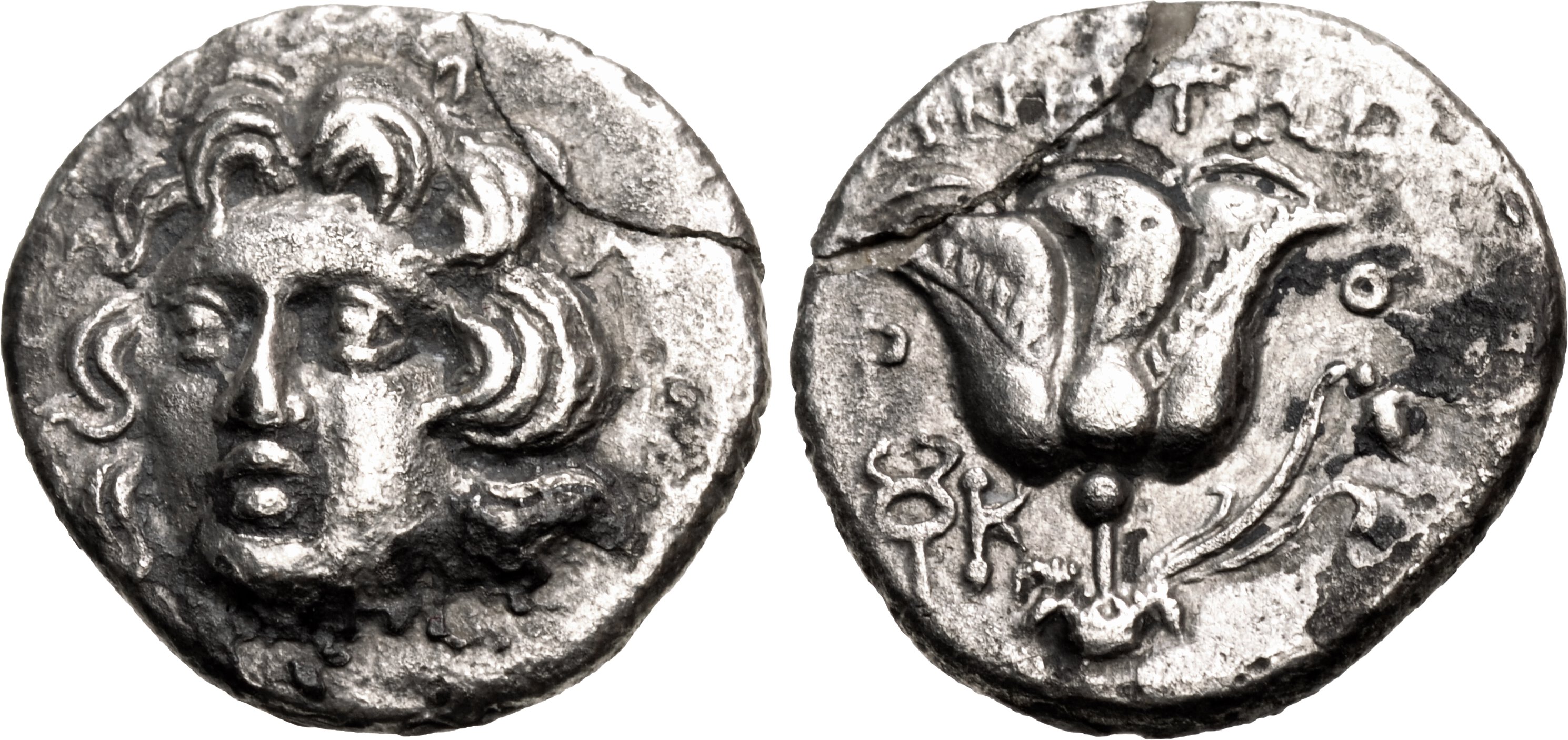S 2107 - Crete (uncertain mint) (Rhodian power), silver, drachms (200-190 BCE)
From SILVER
205 BCE - 200 BCE Silver 7,432 kg
Description
| ObverseInscription or printing placed on the obverse.: | Head of Helios facing slightly left |
| ReverseInscription or printing placed on the reverse.: | AINHTΩP above, P-O across field (Greek).Rose with buds to left and right, kerykeion and K to left |
Mint and issuing power
| MintIdentifies the place of manufacture or issue of a numismatic object.: | Crete (uncertain mint) | Ancient regionAncient region.: | Crete | Modern countryModern country: Greece | AuthorityIdentifies the issuing power. The authority can be "pretended" when the name or the portrait of X is on the coin but he/she was not the issuing power. It can also be "uncertain" when there is no mention of X on the coin but he/she was the issuing power according to the historical sources: | Rhodian power |
Chronology
| FromIdentifies the initial date in a range assigned in a numismatic context. | 205 BCE | toIdentifies the final date in a range assigned in a numismatic context.. | 200 BCE | PeriodTime period of the numismatic object.: Hellenistic 323-30 BC |
Physical description
| MetalThe physical material (usually metal) from which an object is made.: | Silver |
Median weightMedian of the weights of numismatic objects (in grams). in grams | 2.50 | DenominationTerm indicating the value of a numismatic object. Examples: tetradrachm, chalkous, denarius.: | drachma |
StandardStandard.: | Rhodian |
Image

S2107 Crete Rhodes drachms Ashton 334-344.jpg [1]
References
| Die study referencePublication of the study: | Ashton 1987b1Ashton 1987b, Ashton 20012Ashton 2001, p. 110-111, n° 334-344 | ||
| Coin series referenceReference to coin series study: | |||
| Coin series web referenceCoin series web references: | |||
Obverse dies distribution
no distribution is available
Reverse dies distribution
no distribution is available
Quantification
| Number of obversesNumber of obverse dies. ᵖ (o) | 96 | Number of singletons (o1)The number of singleton coins. ᵖ | |
| Number of reverse diesNumber of reverse dies. (r) | Number of coinsNumber of coins. (n) | 204 | |
| Coins per obverse dieNumber of coins per obverse die. (n/o) | 2.13 | Coins per reverse dieNumber of coins per reverse die. (n/r) | |
| Reverse per obverse ratioRatio of obverse dies divided by reverse dies. (r/o) | Percentage of singletons (o1)number of coins (n) divided by the number of singletons (o1) ᵖ | % | |
| Original number of dies (O) (Carter 1983 formula)The estimation of the number of coins according to Carter 1983 ᵖ | 148.63 | Coins struck if 20,000 as average productivity per dieCoins made if the average productivity for obverses (according to Carter) is 20,000. ᵖ | 2,972,600 |
| Original number of dies (O) (Esty 2011 formula)The estimation of the number of coins according to the singleton formula in Esty 2011 ᵖ (O) | 181.33 | Survival rate if 20,000 as average productivity per dieSurvival rate if average productivity is 20,000. ᵖ | 0.00007 |
| Coverage (o = % of O) (Esty 1984 formula)Esty 1984 - coverage (% of O) ᵖ (o = % of O) | % | Die productivity if survival rate 1/2,000Average productivity if survival rate is 1/2,000. ᵖ | 2,745.07 |
| Weight of silver (in kg) if 20,000 coins per die (O = Carter formula)Carter 1983 * Median weight * 20000 (*10 if gold or electrum) ᵖ | 7,432 kg <br /> 7,432 kg | Die productivity if survival rate 1/5,000Average productivity if survival rate is 1/5,000. ᵖ | 6,862.68 |
Remarks
References
- ^ Ashton, Richard (1987), "Rhodian-Type Silver Coinages from Crete," Schweizer Münzblätter, 37 (146), p. 29-39.
- ^ Ashton, Richard (2001), "The coinage of Rhodes 408-c.190 BC", in Andrew Meadows and Kirsty Shipton (eds.), Money and its uses in the ancient world, Oxford, Oxford University Press, p. 79-115.